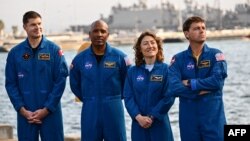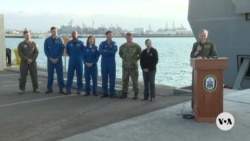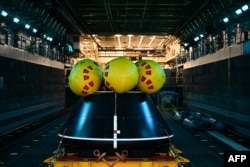The USS San Diego is a warship designed to deliver troops and equipment into combat zones, something the crew routinely trains for from their base in San Diego, California, on the coast of the Pacific Ocean.
But a closer look at the patches and colors of some of the uniforms on board recently are clues that one of their current missions has objectives about as far away from a theater of war as one can get.
“This is a unique opportunity, but this is well within the wheelhouse of what we do day in and day out,” says Lieutenant Jackson Cotney, a U.S. Navy helicopter pilot attached to the USS San Diego conducting search and rescue training operations supporting NASA’s Artemis crewed missions to the moon.
During recent exercises in the Pacific Ocean, Cotney and hundreds of sailors worked with NASA’s four-person Artemis II crew to prepare for a critical part of the complex operation — the safe return and recovery of the Orion capsule and crew once it completes reentry through Earth’s atmosphere.
“This is the 11th underway recovery test,” but the first with astronauts engaged in the training, explains Captain David Walton, who is the commanding officer of the USS San Diego. “Once the crew comes back, really their health and welfare is our number one concern. Getting them out of the capsule and getting them medical treatment rapidly is what we’re driving for, and then recovering the equipment for further flights back to the moon or further.”
Cotney is already an Artemis veteran. He piloted one of the helicopters monitoring the uncrewed Orion capsule that touched down in the Pacific Ocean at the end of the 25-day Artemis 1 mission in 2022, which orbited the moon and traveled the farthest into space of any craft designed to carry humans.
“We were the first platform up at 10,000 feet to see that the capsule was intact as it came over the horizon,” he told VOA during a recent interview on board the San Diego. “Super exciting to see it come out of the sky. This mission itself is new to me, but not new to naval aviation. Naval aviators and the naval helicopter community have been rescuing astronauts, picking up astronauts out of the water since the early Apollo days.”
Although NASA has delayed the launch of a crewed mission to orbit the moon until 2025 at the earliest, it has already selected four astronauts for the first such journey in more than 50 years.
“This Artemis mission campaign is not just about going back to the moon and going back responsibly and sustainably, it’s about building on what we learned there and exploring even deeper and answering some of those fundamental questions that we all have about ourselves,” says Christina Koch, who could make history as the first woman to orbit the moon. “What does it mean to be human, are we alone in the universe, how did we all get here?”
Speaking at a press conference at the conclusion of their session aboard the San Diego, Koch said the training isn’t preparing them just for a path already forged by astronauts five decades ago. It’s helping them compete in a new “space race,” in which the United States isn’t the only country with aspirations beyond Earth’s orbit.
“The question really isn’t why we go; it’s are we going to lead or are we going to follow. To see this team work together and innovate to come up with a unique solution for getting four people out of the Pacific Ocean, the answer was very clear to me that we are going to be leading,” he says.
“Space kind of got back to being cool,” says Lieutenant Derek Pelletier, who, along with most of the crew of the San Diego, wasn't alive the last time people reached the moon. But they know their role in this training is one small step in NASA’s greater leap in the Artemis program that doesn’t stop on the lunar surface.
“The next step is going to be to Mars and beyond, so knowing that we played a part in getting humanity back to the moon and out to the space frontier is going to be fantastic to us, so the importance that we feel as a crew is great,” he says.
NASA astronauts Koch, Reid Wiseman and Victor Glover and Canada’s Jeremy Hansen could orbit the moon as early as September 2025. The return of astronauts to the lunar service is scheduled for the following mission — Artemis III — which NASA plans to launch in 2026.












